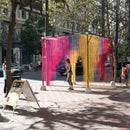Introduction: Architecture in the Making: Varied Layers Facade Prototype
Designers: Reynaldo Kambey and Setareh Taghvaei
This project is the product of an architecture design studio taught by Adam Marcus (Variable Projects) and Margaret Ikeda & Evan Jones (ASSEMBLY) at California College of the Arts Division of Architecture in spring, 2014. The studio, titled "Architecture In The Making," explored pragmatic opportunities for leveraging digital fabrication technologies in the design and construction of highly performative building facades. While developing proposals for a new building for REALM Charter School in Berkeley, California, the studio collaborated with the Autodesk / Instructables Pier 9 Workshop in San Francisco to produce a series of full-scale building envelope prototypes. Fabricated from 18 ga. steel, these prototypes allowed the students to work at 1:1 scale and to develop a comprehensive understanding of performance, detailing, and assembly. (See this link for more information on the studio.)
This project, Varied Layers, was designed by students Reynaldo Kambey and Setareh Taghvaei. It builds upon a one-week design exercise in which students designed a small farm stand structure in rural California. The purpose of the exercise was to explore how a building enclosure could be designed to address multiple functional requirements. (See this link for Reynaldo & Setareh's Instructable for their farm stand project.)
Step 1: Building Design
This project is organized around a series of layered spaces and varying degrees of transparency to articulate the interior programs of the school. Qualities of transparency and openness emphasize the collaborative culture of REALM Charter School. The building facade is used both to modulate these conditions of transparency and communicate REALM's identity to the surrounding context, with the school's logo incorporated into the design.
Step 2: Facade Design
The envelope system amplifies the building's layered conditions through its intricate paneling system that varies in section to provide gradients between pure transparency and pure opacity. The screen is composed of scale-like panels that open and close based on program, daylighting needs, and privacy, and from certain vantage points, it almost dematerializes. The variation of the panels was determined by analysis of the building programs and solar exposure.
Step 3: Fabrication Process
Three prototypes were produced in the development of the facade system. Each of these prototypes was fabricated on the Omax waterjet at the Pier 9 Workshop in San Francisco. The process for each prototype included the following steps:
- Modeling of the parts in 3D software.
- Flattening / unrolling 3D geometry into a 2D line drawing.
- Export drawing as a DXF file.
- Complete toolpathing in the Omax Layout pathing software. Important considerations for these prototypes included making sure that the water jet (which has a thickness to it) was directed along the correct side of each cut line.
- Fabricate the parts using the Omax Make software.
The concept that was proposed in the initial farmstand project incorporated operable panels that could rotate in place to modulate view angles and air flow through the facade. Although the idea of operability was left behind, the concept of varying the panels' angle of rotation became the primary driver for the subsequent prototyping and research. The panel design evolved from sharp geometry with a large number of folds to a more simple module that is rounded in form and produces a much softer effect across the building.
Step 4: Assembly Process
The prototypes were all assembled at CCA's shop. The bends in the panels were made using a press break. Standard steel unistrut framing was used for backup structure.
The assembly drawing above documents the assembly process both for the prototype and for a speculative installation on a building facade.
Step 5: Final Prototype
The final prototype measures 45"w x 54"h and was presented at the studio's final review on May 3, 2014 at CCA.













